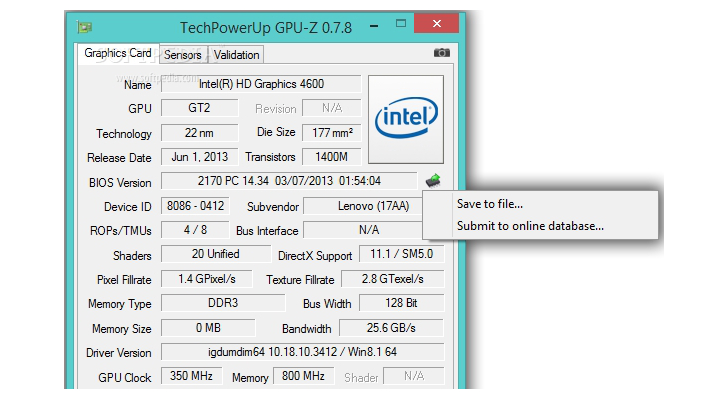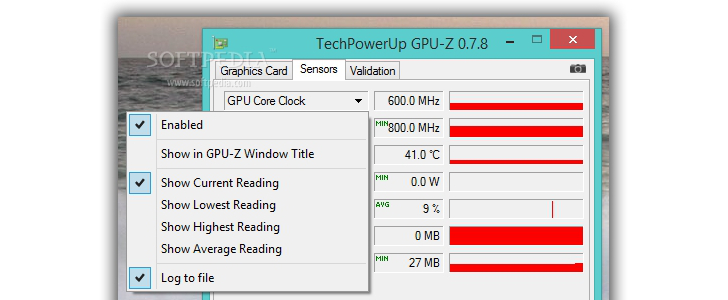Gathering information about your video card and GPU is an essential process if you want to troubleshoot the problems that may appear while playing games, such as crashes, hangs, or stutters. Video card performance fluctuates from one game engine to another and this pretty much depends on the card's main capability: multi-texturing, pixel shading, full screen anti-aliasing, or other features.
GPU-Z is a small freeware that provides comprehensive information about your video card and GPU. It was specifically designed for all tech enthusiasts who want to know each detail about their card and graphics processing unit’s superpowers.
The application offers support for the NVIDIA, ATI, and Intel Graphics devices. You can find out data about your graphics card, such as name, release date, transistors, BIOS version, as well as memory type and size.
Plus, the utility displays the GPU core and memory clock, temperature, GPU load and fan speeds with the aid of real-time graphs and filtering options. Monitoring the video card clock rates proves to be particularly useful in case you suspect that your video card suffers from overheating.
GPU-Z’s sole purpose is to help you collect information, so it doesn’t act as an overclocking program. If you want to underclock your video card, you can use dedicated tools for accomplishing the process, such as ATITool, PowerStrip, or RivaTuner.
If you are running CPU-Z on your computer, the well-known software that comprises a large amount of information related to hardware resources (CPU, caches, mainboard, memory, SPD, graphics), you can use GPU-Z in parallel in order to get a complete description of your video card and GPU.
The advantages of being portable
You can either install GPU-Z on your system or use the standalone version of the utility. If you opt for the portable mode, you can simply run the EXE file for activating the process. Plus, the tool doesn’t leave any traces in the registry, and you may copy it on any USB flash drive or other devices, and transfer it on the target device on the fly.
User interface
The multi-tabbed layout makes it easier for you to discover the application’s features. There are three main tabs embedded in the primary panel that offer quick access to the main parameters: Graphics Card, Sensors, and Validation.
The first one reveals thorough details about the video card detected on your system, while the second lets you apply some filters, log the process, and view real-time graphs. You can also use the built-in validation mode for generating an HTML report on the official website of the program.
Although there’s no support for a help manual, you can rely on the tooltips to give you additional information about each feature. You can run the tool at Windows startup and make it stay on top of other applications, select the language for the tooltips, check for updates, as well as pick the measurement unit (Celsius or Fahrenheit).
Graphics card data
GPU-Z automatically loads the information about your video card when you run the tool. Tests revealed that the utility shows the details extremely quickly and without putting a lot of stress on your system.
You can check out the following details about your video card: name, GPU title, technology process, die size (its physical surface area), number of transistors, release date, BIOS version, device ID, subvendor, ROPs (Render Output Pipelines)/TMUs (Texture Mapping Unit), bus interface, shaders, DirectX support, texture fillrate, memory type and size, bus width, and bandwidth.Additionally, you can view the driver version, GPU clock and memory, default clock and memory, as well as 3D clocks (if they are available), and check if there’s support on your system for OpenCl, CUDA, PhysX, and DirectCompute 5.0.
What’s more, the tool lets you export the BIOS data to a file or upload it to the official website of the program and launch a test in order to verify PCI Express (Peripheral Component Interconnect Express) slot configuration. Graphics cards feature a power-saving mode which reduces the PCI Express speed and width to lower levels in order to conserve power when the card is idle.
The test allows you to enable the highest power state of your card, so you can properly verify the PCI Express speeds. You may trigger the test in a full screen mode or view the animated display in a small pane.
Sensors
GPU-Z allows you to keep an eye on your GPU core and memory clock, temperature, power, load, as well as memory usage (dedicated and dynamic). The best part about it is that it provides real-time graphs for monitoring all of the aforementioned parameters.
Furthermore, you can enable or disable each monitoring process displayed in the Sensors category, reveal the desired GPU value (e.g. core clock, temperature) in the window title of the utility, as well as show the current, lowest, highest, or average recorded values by selecting the desired filter from a drop-down list or simply clicking on the GPU value.
Additionally, you are allowed to log the entire operation and export data to plain text file format, alter the sensor refresh rate by selecting from several preset values (from one up to ten seconds), and continue refreshing the Sensors screen while GPU-Z runs in the background.Last but not least, the application empowers you to take screenshots by simply pressing the dedicated button which is embedded in the top left corner of the main window. The snapshots can be exported to GIF file format, provided that you have specified the filename and saving directory, or uploaded to a free image hosting platform (while generating a link).
 14 DAY TRIAL //
14 DAY TRIAL // 



